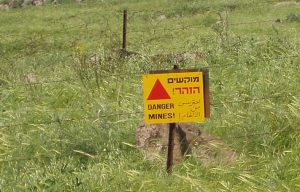×


We have detected your country as:
Please click here to go to the USA website or select another country from the dropdown list.

Minefield warning on the Golan Heights
Wednesday, 19 April 2017 | Israeli researchers have devised a way to detect buried landmines using a system of glowing bacteria and lasers.
Landmines, which kill or injured an estimated 15,000 to 20,000 people each year worldwide, emit small quantities of explosive vapors. Researchers from Hebrew University headed by Prof. Shimshon Belkin of the Alexander Silberman Institute of Life Sciences discovered that certain bacteria release a fluorescent signal when they come into contact with these vapors, The Times of Israel reported.
The researchers tested their observations by planting the bacteria in specially designed beads amidst a field of buried landmines. The field was then scanned remotely by lasers which were able to detect the mines by the bacteria’s glow.
The researchers believe that this is the first time landmines have been detected remotely.
“Our field data show that engineered biosensors may be useful in a landmine detection system,” Belkin said in a statement. However, Belkin cautioned that more work needed to be done to perfect the system, including improving the sensitivity and stability of the bacteria, increasing the speed of the scan to cover larger areas, and making the scanning apparatus smaller so that it can be fit onto unmanned vehicles or drones.
Israel has numerous areas that have been populated with landmines, including the Arava Valley, areas along the Jordan Valley, and the Golan Heights, which Israel captured from Syria during the Six Day War. While these zones have been marked off with warnings, landmine accidents still occur there every few years.
Posted on April 19, 2017
Photo Credit: David Shay/ Wikimedia
Photo License: Wikimedia
All logos and trademarks in this site are property of their respective owner. All other materials are property of Zealous 8:2. Copyright © 2025.
Website Site Design by J-Town Internet Services Ltd. - Based in Jerusalem and Serving the World.